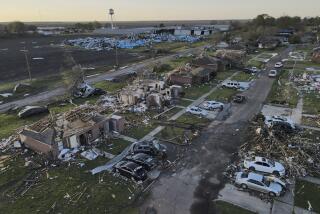Mold Likely to Complicate Rebuilding After Katrina
- Share via
The Gulf Coast is facing a potential financial and legal morass over mold blooming inside storm-damaged buildings, according to scientists, contractors and insurance experts.
Mold has grown thickly on wet walls, rugs and furniture of thousands of buildings -- and the problem will worsen as flood waters recede.
Restoration workers are pouring into the Gulf Coast.
“There’s an Oklahoma land stampede down there,” said John Shane, a manager for Environmental Microbiology Laboratory Inc. in Chicago.
Some molds cause structural problems such as dry rot, requiring the replacement of wood. The biggest problem, however, involves the widespread, but unsubstantiated, contentions that some molds can cause serious health problems.
“There’s a real industry being created around the mold problem -- lawyers who’ve written about it call it ‘black gold.’ They see it as the next great asbestos,” said Dr. Dorsett Smith, clinical professor of medicine at the University of Washington in Seattle. “It is the fear factor. You mention the word ‘mold’ and people are afraid.”
Mold is a general term for a group of thousands of different fungi, including Penicillium, original source of the antibiotic penicillin, and Stachybotrys chartarum, a black fungus with a fearsome reputation for its supposed effects on people’s health.
Mold spores are always in the air, but they only germinate when there is enough warmth and moisture, such as from burst water pipes, condensation, storm damage or flooding.
Feeding on the cellulose in wall board, ceiling tiles and wood, they grow into long microscopic strands, spawning millions of new spores that people can inhale.
Publicity about Stachybotrys has created an industry for removing “toxic black mold.”
In extreme cases, the presence of the mold has caused people to abandon their homes and remove the earth beneath them because of their fear of sickness.
The presence of Stachybotrys has resulted in multimillion-dollar judgments against insurers and contractors.
Scientists say that molds can cause some health problems. In 2004, a report from the National Academy of Sciences concluded that indoor mold can exacerbate symptoms such as upper respiratory irritation, coughing and wheezing in people with asthma.
In rare cases, it can cause a flu-like immune disorder known as hypersensitivity pneumonitis.
Damp environments often found with mold may also cause shortness of breath, lower respiratory illness in healthy children and the development of asthma in people who are prone to it.
The report, however, found no connection between molds and a range of serious conditions, including chronic fatigue, cancer, bleeding of the lungs, rheumatoid arthritis, lupus, memory loss and learning disabilities.
Stachybotrys and some other molds do produce toxins, called mycotoxins, that are dangerous to animals and people if eaten.
But “you can’t get enough mycotoxin inside if you’re breathing the spores,” said Bruce Kelman, a board certified toxicologist with Veritox Inc., a toxicology consulting company.
The problem facing homeowners, insurers and contractors is that there are virtually no health standards on mold decontamination and very little data on what is necessary to get spore numbers down to safe levels.
Because getting rid of mold is expensive, many houses that are still structurally sound may be razed, experts predicted. The problem will be exacerbated by the fact that flood and mold damage is generally not covered by standard home insurance.
The field of mold removal also has its share of ill-trained and unscrupulous contractors, experts say.
“You’ll have to watch for people coming out of the moldy woodwork to take advantage of the situation regardless of training,” said Meredith Blackwell, a fungus expert at Louisiana State University in Baton Rouge, La.
Sitting damp and unrepaired for weeks, houses in the Gulf Coast region provide especially good conditions for mold growth.
“Mold is definitely going to be a huge, huge issue,” said Felix Ontiveros, president of TRC Disaster Solutions of Tulsa, Okla.
Ontiveros said his crews had been working since the first days after the hurricane in the Gulfport, Miss., area and in the outskirts of New Orleans. He said his clients reported thick mold on walls.
“We’re going in there suited up,” Ontiveros said.
Mold remediation typically involves removing moldy wallboard and stripping a building to its frame. Workers wear protective suits and contain mold spores by sealing the building with plastic sheets and filtering the air. Other steps include wiping the structure or spraying wood with chemicals to kill the mold. Only then is a building rebuilt.
Elliott Horner, principal consultant of Air Quality Sciences, an air quality consulting company based in Marietta, Ga., said the damage from Hurricane Katrina had underscored the rudimentary science of mold removal.
“These things are great and wonderful when you’ve got one building in a community that needs to be fixed -- but we’ve got the inverse situation, we’ve got most of the buildings that need to be fixed,” Horner said. “It is too expensive and too slow.... We need to be better and faster.”
Horner said he hoped that lessons would come out of the Gulf Coast restoration about which mold remediation techniques were necessary.
Joey Spatafora, a mycologist at Oregon State University, said that he and some colleagues were planning to study the molds that had emerged.
“We know something about how E. coli and cholera behave in a disaster like this,” Spatafora said, “but as far as things like Stachybotrys chartarum and wood decay fungi ... that is unknown.”
More to Read
Sign up for Essential California
The most important California stories and recommendations in your inbox every morning.
You may occasionally receive promotional content from the Los Angeles Times.













